Patrols keep US boaters in line, protect killer whales
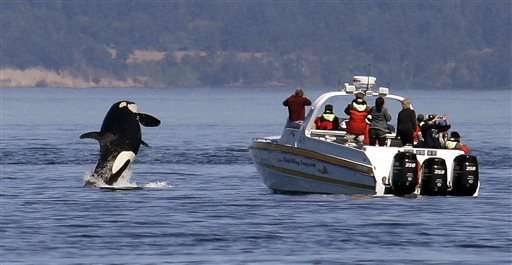
Against a backdrop of rocky bluffs, a pod of orcas jumped out of the emerald waters of the Puget Sound before splashing their massive black-and-white bodies back into the water.
Shadowing the whales on a recent afternoon were several recreational and commercial whale-watching boats that ferry people out to watch the orcas breach, one of nature's most impressive spectacles. But the combination of boats and whales has state and federal authorities worried now that the Southern Resident pod of killer whales has four new calves.
So authorities are sending out orca patrols, asking the boats to give the deadly sea mammals enough space.
By law, boaters are required to stay 200 yards (183 meters) parallel from the orcas and give them 400 yards (366 meters) in front to create conditions that will help the whales restore their numbers.
"We approximately do 60 shifts per summer solely dedicated to whale protection," said Sgt. Russ Mullins of the Washington state department of Fish and Wildlife.
The Southern Resident killer whales have lost about 20 percent of their population since the 1990s. Dwindling food sources and contamination are two reasons scientists blame for their decreasing numbers. This particular group of whales, now numbering at 81, is endangered. That's why the births of four new calves were welcome news.
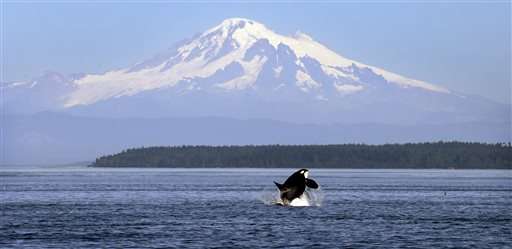
"It's a little bit of a baby boom," said Lynne Barre, an orca expert for the National Oceanic and Atmospheric Administration. "We still have a lot work to do to get to a fully recovered population."
The patrolling officers mostly warn boaters, opting to educate skippers about the laws protecting the marine mammals. The law enforcement presence in the Puget Sound is being funded by a $1 million NOAA grant.
Boats present a whole host of other problems for the whales. Noise from motors interferes with the orcas' echolocation, which they use to find salmon to eat.
"When boats are near the whales, they can change their behavior. They feed less often. They swim in less direct patterns. They also increase these highly energetic surface-active behaviors, like breaching and tail slapping," Barre said.
Breaching, one of the main attractions for whale watchers, could be costing them too much energy, Barre said. Other research shows the orcas talk louder when boats are around.
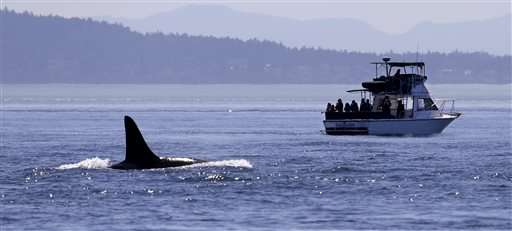
The Whale Museum in Friday Harbor estimates that about half a million people come to these waters to watch whales every year, generating up to $50 million for the commercial whale watching industry.
While the commercial whale watching industry is growing, authorities say they've been doing a good job of self-policing.
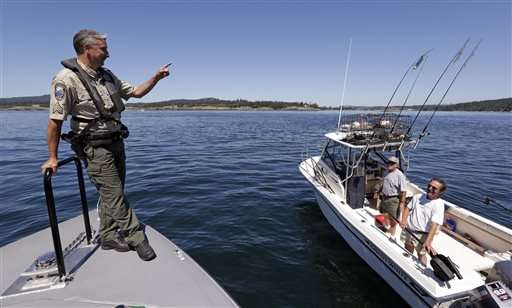
"We knew you can't have whale watching if you have no whales," Michael Harris, executive director of the Pacific Whale Watch Association, which has 34 members.
So the main focus for officers has been recreational boaters "who either don't know what the rules are, they don't know the impact they could potentially have, or they don't care," Mullins said.
-
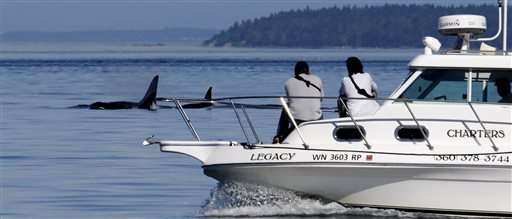
In this photo taken July 31, 2015, passengers aboard a commercial boat watch orca whales swim past in the Salish Sea in the San Juan Islands, Wash. The combination of boats and whales has state and federal authorities worried, especially this year, now that the Southern Resident pod of killer whales has four new calves. By federal and state law, boaters are required to stay 200 yards parallel from the orcas and give them 400 yards in front. (AP Photo/Elaine Thompson) -
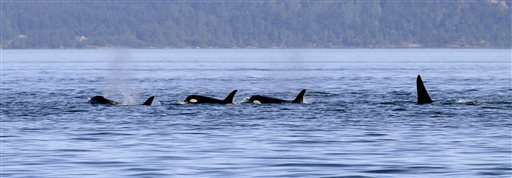
In this photo taken July 31, 2015, four orca whales swim in the Salish Sea in the San Juan Islands, Wash. The Southern Resident killer whales living in the area have lost about 20 percent of their population since the 1990's, likely because of dwindling food sources and contamination. This particular group of whales, now numbering at 81, is endangered. (AP Photo/Elaine Thompson) -
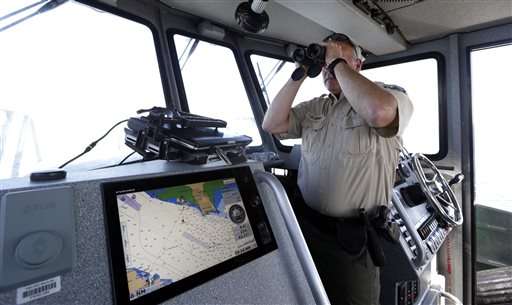
In this photo taken July 31, 2015, Washington Dept. of Fish and Wildlife Marine Ofc. Ralph Downes uses binoculars to view the area around him in the Salish Sea in the San Juan Islands, Wash. The combination of boats and whales has state and federal authorities worried, especially this year, now that the Southern Resident pod of killer whales has four new calves. By federal and state law, boaters are required to stay 200 yards parallel from the orcas and give them 400 yards in front. (AP Photo/Elaine Thompson) -
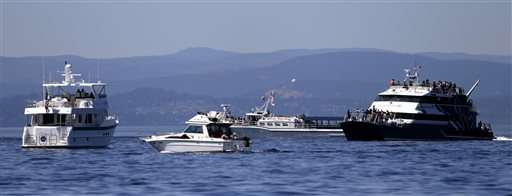
In this photo taken July 31, 2015, commercial and recreational boats gather to watch orca whales in the Salish Sea in the San Juan Islands, Wash. The combination of boats and whales has state and federal authorities worried, especially this year, now that the Southern Resident pod of killer whales has four new calves. By federal and state law, boaters are required to stay 200 yards parallel from the orcas and give them 400 yards in front. (AP Photo/Elaine Thompson) -
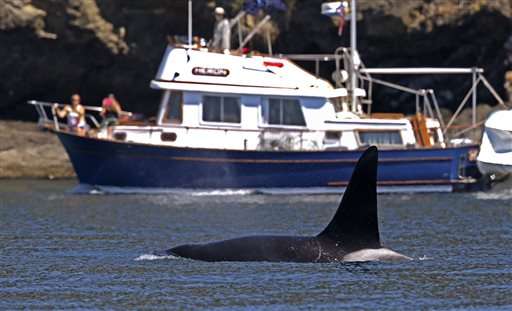
In this photo taken July 31, 2015, an orca whale swims past a recreational boat sailing just offshore in the Salish Sea in the San Juan Islands, Wash. The combination of boats and whales has state and federal authorities worried, especially this year, now that the Southern Resident pod of killer whales has four new calves. By federal and state law, boaters are required to stay 200 yards parallel from the orcas and give them 400 yards in front. (AP Photo/Elaine Thompson) -
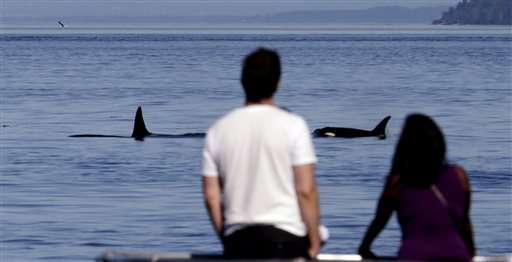
In this photo taken July 31, 2015, passengers aboard a boat watch a pair of orca whales swim past in the Salish Sea in the San Juan Islands, Wash. The combination of boats and whales has state and federal authorities worried, especially this year, now that the Southern Resident pod of killer whales has four new calves. By federal and state law, boaters are required to stay 200 yards parallel from the orcas and give them 400 yards in front. (AP Photo/Elaine Thompson) -
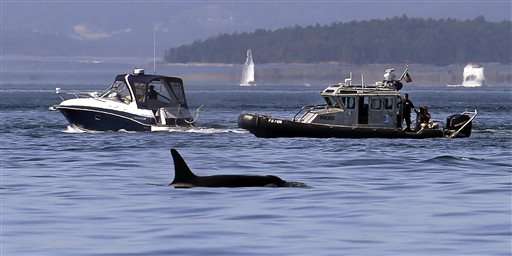
In this photo taken July 31, 2015, a NOAA law enforcement patrol boat, right, is stopped near a recreational boat going past as an orca whale swims in view in the Salish Sea in the San Juan Islands, Wash. The combination of boats and whales has state and federal authorities worried, especially this year, now that the Southern Resident pod of killer whales has four new calves. So authorities are sending out orca patrols, asking the vessels to give the sea mammals enough space. (AP Photo/Elaine Thompson)
© 2015 The Associated Press. All rights reserved.


















